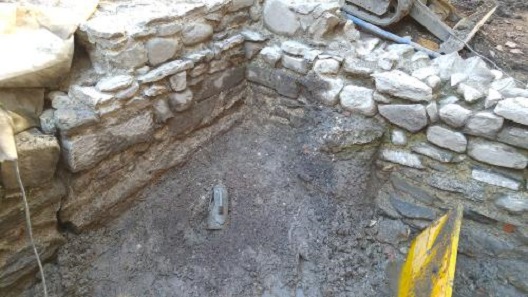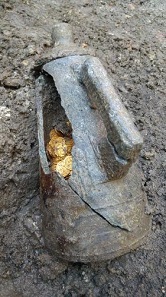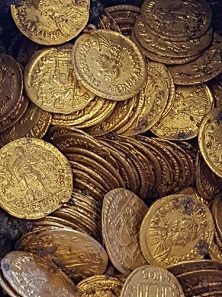by Björn Schöpe
Translated by Leonie Schulze
September 27, 2018 – The old theater building would have probably been torn down earlier if people had known that a treasure was hiding underneath it. The former Cressoni Theater of Como had not been in use for a long time and even its later use as a cinema had been given up several years ago.
Construction workers found an ancient jar made of soapstone underneath the former Cressoni Theater in Como. Image: Ufficio Stampa Ministero Beni Culturali.
But just shortly after demolition work had begun, it was stopped already. The reason was a spectacular treasure find.
A tear in the jar revealed the valuable content: Hundreds of solidi dating back to late antiquity. Image: Ufficio Stampa Ministero Beni Culturali.
300 solidi
In early September of 2018, construction workers found an unusual jar made of soapstone. A tear in the jar allowed for a glimpse of its valuable content: gold coins. Demolition work was temporarily stopped and the authorities responsible for the protection of monuments secured the find, which a gold bar hidden in another jar was later added to. The objects have since been taken to a restoration laboratory in Milan for further analysis.
In a press conference, officials presented the find and carefully uttered an initial interpretation. The discovered objects are said to be about 300 gold coins and a gold bar dating back to late antiquity. The gold coins were stored in an unusually shaped soapstone jar and were, as the numismatist in charge Maria Grazia Facchinetti is quoted in the media, “stacked in rolls similar to those seen in the bank today”.
It appears as though someone had diligently stacked the coins in rolls. Image: Ufficio Stampa Ministero Beni Culturali.
The solidi are said to have been minted on behalf of the emperors Valentinian III (rule 425-455), Leo I (rule 457-474), and Libius Severus (rule 461-465) and they are exceptionally well-preserved. It might have been the deposit of an institution that was buried at the end of the 5th century. Italian media outlets quickly spread the news that the find was of inestimable value or at least worth several million euros.
Along with coins of the Western Roman emperor Valentinian III and his later Eastern Roman colleague Leo I, the hoard also contains some particularly rare pieces: solidi of Libius Severus who only ruled in Rome for four years. Image: Ufficio Stampa Ministero Beni Culturali.
Market value vs. gain in knowledge
We are still awaiting the results of the analysis, but let us base the following figures on experience. It appears as though all of the solidi are of extremely fine condition. The most expensive pieces are likely to be the rare coins of Libius Severus, which can be estimated to be worth about 10,000 euros. However, the find probably does not contain a lot of his coins. Comparable solidi of Leo I can be purchased for 500 euros, solidi of Valentinian III of perfect grade are worth 1,200 to 1,500 euros. Let us be generous and assume that coins of Libius Severus make up 10% of the find. This calculation would result in the market value of the entire hoard amounting to a little more than half a million. Sales value that is!
In countries where hoard finds are allowed to be sold to coin dealers, the purchase value is estimated at about half to two quarters of the sales value. This would result in the hoard being worth an actual price of about 250,000 to 350,000 – not several million. That is quite a lot, by the way. Only rarely do we discover hoard finds in Europe of such a high market value
And what if the coins of Libius Severus make up the majority of the treasure after all? Then the price of these coins would fall drastically. And of course one has to keep in mind that a potential dealer would not be able to sell the entire bulk of coins immediately.
What is not part of this calculation, however, is the value of this find in terms of research and science. We have to wait and see what information will be revealed after further analysis.
The sack of Rome by vandals led by their king Genseric in AD 455 (depicted in a highly imaginative picture from the 19th century here) demonstrates that the emperors could no longer protect Italy. Wealthy Romans were well advised to bury their coins and thus secure their fortune.
The powerful fleet of Comum Novum
The composition of this treasure visualizes the complicated historical situation: Valentinian III was a descendant of the dynasty of Theodosius and thus for a long time remained an important link for the following emperors. Leo I ruled over Byzantium and, in the light of the turmoil in the West, was considered the only unrestrictedly recognized authority. East Rome approved the decisions in the West during the 5th and 6th century. More often than not, these decisions were not made by the emperors of Rome, who weren’t much more than marionettes in the hands of politically ingenious puppet-masters who contented themselves with the title of magister militum, “master of the soldiers”. Libius Severus was one of those marionettes, too, but he either passed away early after a couple of years or was removed by his Gothic magister militum Ricimer.
While the “good Barbarians” controlled the emperors and supplied soldiers, the other Barbarians invaded the empire at the borders. One of the most important bulwarks in Northern Italy was the fleet of Comum Novum, located where we find Como today, at Lake Como. It was supposed to secure the waterway trade routes. And that was also were one would find the villas of the wealthy aristocracy. Further excavations could determine whether the hoard find can be assigned to an aristocrat from said region.
The monetary economy disappears
Political turmoil does not only signify economical uncertainty but also a return to self-subsistence. Someone who does not know whether there will be supplies offered on the market, has to grow food in their own little garden. Or they withdraw to their villa where all necessities of life are produced.
The Migration Period put an end to the progressive monetary economy of the Roman Empire. During that time, coins once again became an exceptional item, one that would only be used for large payments – or something you could use to hoard your fortune, just like our Roman did with the treasure of Como.
Among many others, CNN have reported on this treasure find.
CoinsWeekly has reported on a metal detectorist from the Netherlands who found a hoard of 20 solidi from the 4th century.
Metal detectorists in Great Britain found a large hoard of solidi several years ago.









